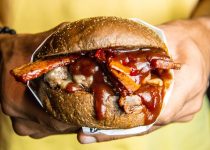How to Cook Ribs on Grill Rotisserie
When it comes to cooking ribs on a grill rotisserie, it's like discovering a secret passage in your favorite book – you never knew what you were missing until you stumbled upon it.
The sizzle of the grill, the tantalizing aroma of seasoned ribs slowly rotating, and the anticipation of that first mouthwatering bite make it an experience you won't soon forget.
But how do you achieve that perfect, fall-off-the-bone tenderness and rich, smoky flavor?
Let's uncover the secrets together and elevate your grilling game to a whole new level.
Choosing the Right Ribs
When selecting ribs for grilling, it's essential to choose cuts that are well-marbled with fat for maximum flavor and tenderness. The most popular types of ribs for grilling are baby back ribs and spare ribs.
Baby back ribs are leaner and shorter, offering a tender bite and a slightly sweeter flavor. Spare ribs, on the other hand, have more fat and connective tissue, resulting in a rich, succulent flavor. Consider your flavor preferences when making your selection. If you enjoy a meatier and more robust taste, spare ribs might be your top choice. However, if you prefer a leaner and slightly sweeter flavor, baby back ribs could be the perfect fit for you.
Once you have selected your preferred type of ribs, the next step is to prepare them for grilling. Many grill masters swear by the benefits of marinating ribs before cooking them. Marinating not only enhances the flavor but also helps to tenderize the meat.
Some popular marinating techniques include using a combination of oil, vinegar, and spices, or a savory barbecue sauce. Experiment with different marinades to find the perfect flavor profile that suits your palate.
Preparing the Ribs for Rotisserie
To prepare the ribs for rotisserie, start by trimming off any excess fat and membrane from the ribs to ensure even cooking and better flavor penetration. This step is crucial as it allows the meat to cook more evenly and allows the flavors to infuse the meat properly. Once the fat is trimmed, you can then move on to marinating the meat. Marinating the ribs not only adds flavor but also helps tenderize the meat, resulting in a juicy and flavorful outcome.
Here's a simple marinade recipe for your ribs:
| Ingredients | Instructions |
|---|---|
| 1/2 cup soy sauce | 1. In a bowl, mix together the soy sauce, garlic, brown sugar, and lemon juice. |
| 1/4 cup brown sugar | 2. Place the ribs in a large resealable plastic bag and pour the marinade over the ribs. |
| 4 cloves garlic, minced | 3. Seal the bag and place it in the refrigerator for at least 4 hours, or preferably overnight. |
| 1/4 cup lemon juice | 4. Remove the ribs from the marinade before placing them on the rotisserie. |
| Salt and pepper to taste | 5. Season with salt and pepper before grilling. |
Trimming the fat and marinating your ribs will set the stage for a delicious and tender result on the rotisserie.
Seasoning the Ribs
For a flavorful and succulent result, generously rub the ribs with your favorite dry rub seasoning before grilling them on the rotisserie. The dry rub seasoning can be store-bought or homemade, and it's a crucial step in adding depth of flavor to your ribs. You can customize the flavor profile by using a variety of spices such as paprika, garlic powder, onion powder, brown sugar, cumin, and chili powder. The dry rub should be massaged onto the ribs, ensuring that every part is well-coated for maximum flavor infusion.
If you prefer a wet marinade, there are also plenty of options to explore. From classic barbecue sauce to Asian-inspired marinades, the choices are endless. A good marinade not only infuses flavor but also helps in tenderizing the meat, resulting in juicy, tender ribs.
When it comes to grilling techniques, it's important to maintain a consistent temperature and monitor the ribs closely to prevent burning. The rotisserie feature on your grill ensures even cooking and a beautifully caramelized exterior. Keep an eye on the ribs as they cook, and be ready to baste them with extra marinade or sauce for an added layer of flavor.
Setting Up the Grill Rotisserie
Consider attaching the grill rotisserie securely to the grill before you begin cooking the ribs to ensure even and consistent rotation. Proper setup is crucial for a successful grilling experience.
First, ensure the rotisserie rod is clean and free of any grease or debris from previous use. Next, securely attach the rotisserie forks to each end of the rod, making sure they're tightened to prevent any wobbling during the cooking process.
Setting Up the Grill Rotisserie:
- Rotisserie Maintenance:
- Clean the rotisserie rod thoroughly to avoid any residue impacting the flavor of the ribs.
- Check for any signs of wear and tear, and replace any worn-out components to maintain optimal performance.
- Safety Precautions:
- Double-check that the rotisserie motor is functioning correctly and securely attached to the grill.
- Ensure the rotisserie rod is centered and balanced to prevent any potential accidents during the cooking process.
Cooking and Checking for Doneness
Start by preheating the grill and ensuring the rotisserie motor is functioning smoothly for optimal cooking of the ribs. Once the grill reaches the desired temperature, typically around 225-250°F for low and slow cooking, place the ribs on the rotisserie spit and secure them tightly.
As the ribs cook, it's essential to monitor the temperature to ensure even cooking. Use a reliable meat thermometer to check the internal temperature of the ribs, aiming for around 190-203°F for tender, fall-off-the-bone ribs.
Throughout the cooking process, use temperature control and grilling techniques to achieve the perfect doneness. If the ribs are cooking too quickly, reduce the heat by adjusting the grill's settings or by repositioning the coals. On the other hand, if the ribs need a little extra char, increase the heat or move them closer to the flame for a delicious caramelized finish.
When checking for doneness, look for the meat to have pulled back from the bones and for it to be tender when probed with a fork. Additionally, the ribs should have a beautiful caramelized crust and a rich, smoky aroma. Once these signs are present, your ribs are ready to be taken off the grill and enjoyed.
With a bit of practice and attention to detail, you'll become a master at cooking ribs on a grill rotisserie.
Frequently Asked Questions
Can I Use a Rotisserie Attachment on a Charcoal Grill or Does It Have to Be a Gas Grill?
You can definitely use a rotisserie attachment on a charcoal grill or a gas grill. Both options work well for cooking ribs, so it's really just a matter of personal preference. Enjoy experimenting with your grill setup!
Do I Need to Remove the Membrane From the Back of the Ribs Before Putting Them on the Rotisserie?
Before putting the ribs on the rotisserie, it's best to remove the membrane from the back for more tender and flavorful meat. Cooking tips: season well, use indirect heat, and baste for delicious results.
Can I Use a Dry Rub and a BBQ Sauce on the Ribs, or Should I Stick to Just One Type of Seasoning?
You can definitely use both a dry rub and BBQ sauce on the ribs for delicious flavor combinations. Applying a dry rub first adds depth, while slathering on BBQ sauce towards the end gives that classic sticky, sweet finish.
How Do I Prevent the Ribs From Burning or Drying Out During the Long Cooking Process on the Rotisserie?
To prevent the ribs from burning or drying out on the rotisserie, ensure the grill temperature is moderate and use a water pan to maintain moisture. Baste the ribs with a flavorful liquid to keep them succulent throughout the long cooking process.
Is It Necessary to Let the Cooked Ribs Rest Before Serving, and if So, for How Long?
Before serving the cooked ribs, it's necessary to let them rest for about 10-15 minutes. This helps the meat retain its tenderness and allows it to absorb more flavor. Aim for a serving temperature of around 145°F.




